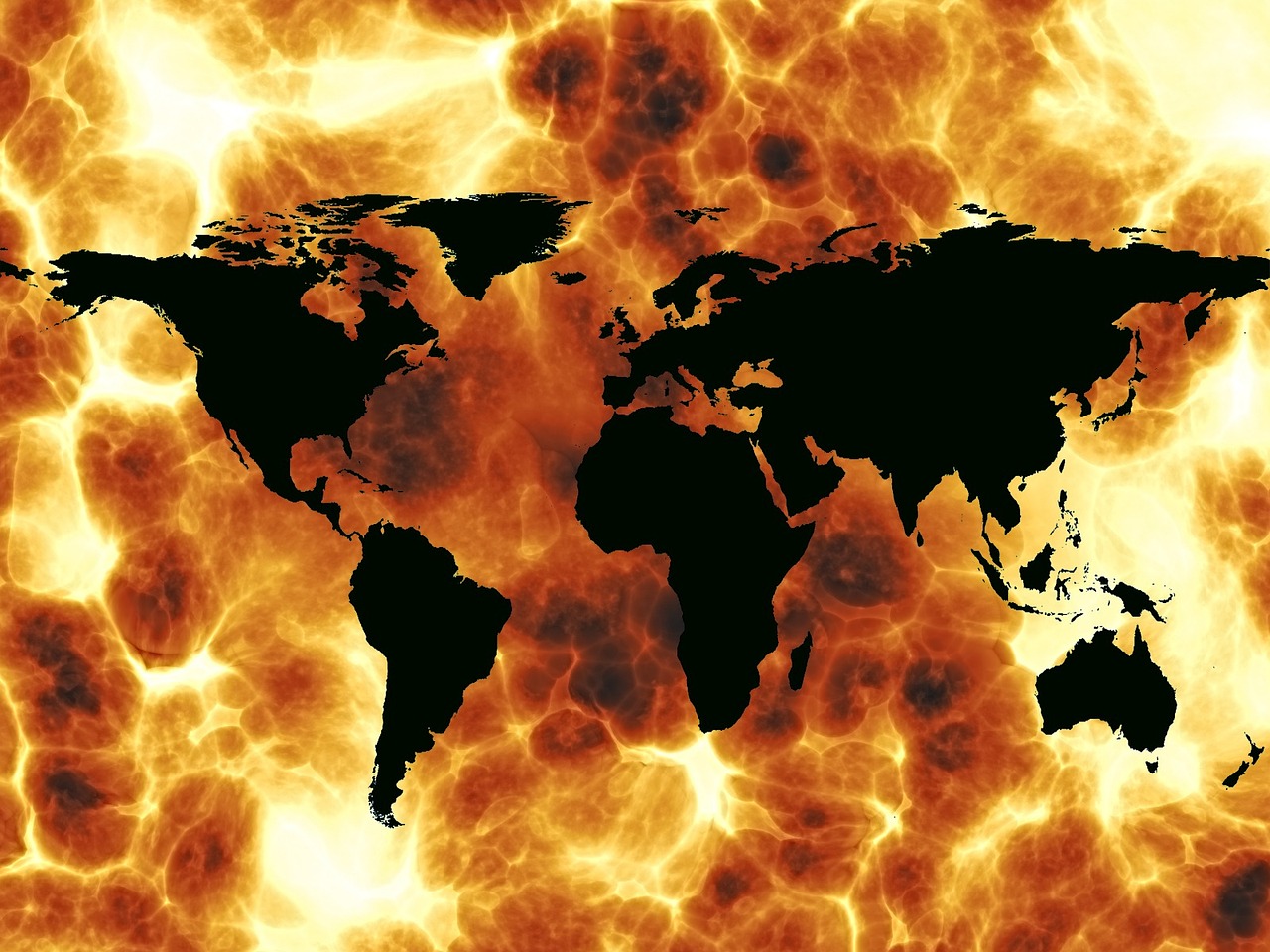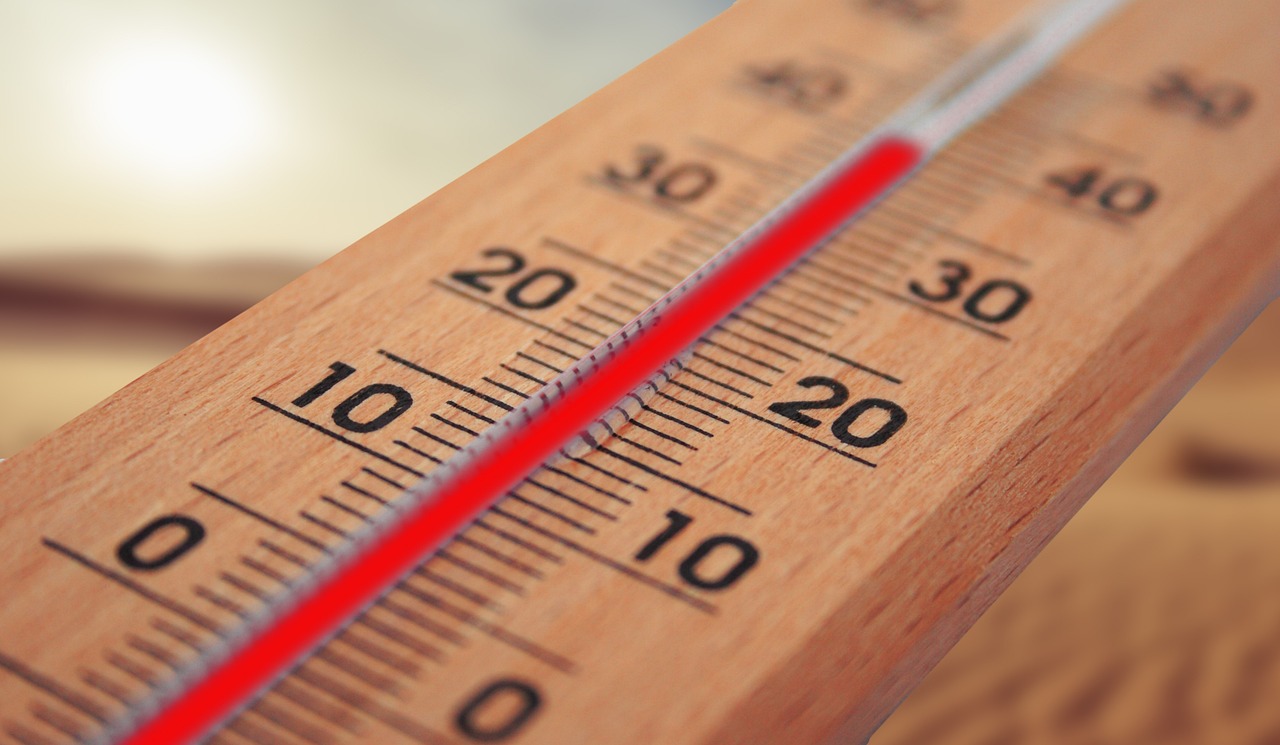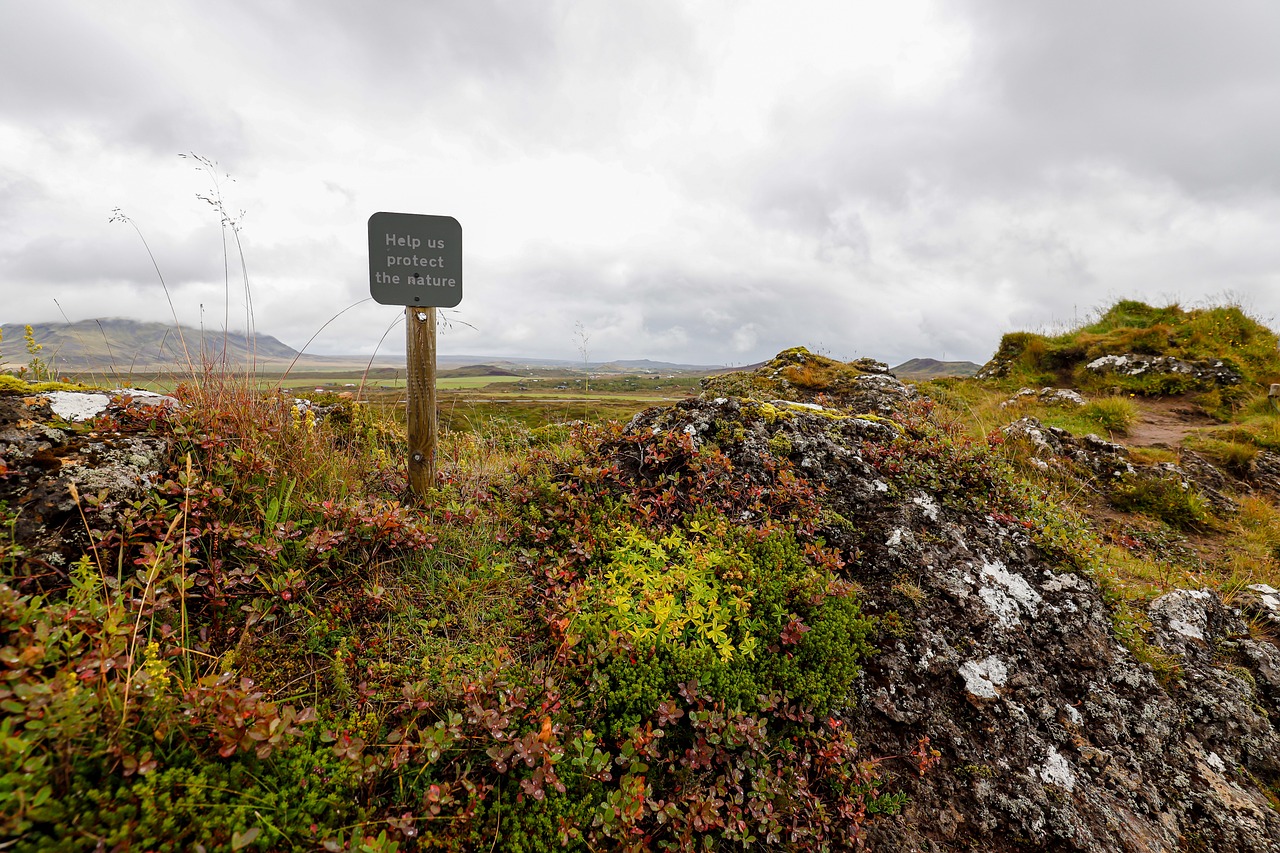Climate Change Effects on Extreme Weather Patterns
Climate change is no longer a distant threat; it's a reality that’s reshaping our planet in profound ways. The intricate relationship between climate change and extreme weather events is becoming increasingly evident. As global temperatures rise, we are witnessing a surge in the frequency and intensity of storms, droughts, and other weather phenomena. This article delves into how these changes are not just statistics but are having real-world impacts on communities, ecosystems, and economies across the globe.
To grasp the effects of climate change on weather patterns, it’s essential to first understand what climate change is. At its core, climate change refers to significant alterations in temperature, precipitation, wind patterns, and other elements of the Earth's climate system. The primary cause of contemporary climate change is the increase of greenhouse gases in our atmosphere, primarily due to human activities such as burning fossil fuels, deforestation, and industrial processes. The scientific consensus is clear: climate change is real, it’s happening now, and it’s largely driven by human actions. Understanding this foundational knowledge is crucial as we explore its effects on extreme weather events.
One of the most alarming consequences of climate change is the increasing frequency and intensity of hurricanes. As the planet warms, ocean temperatures rise, creating the perfect conditions for hurricanes to form and intensify. These storms are no longer just seasonal occurrences; they have become more unpredictable and devastating. Coastal communities are on high alert as they face the wrath of these powerful storms, which are fueled by warmer waters. But how exactly does this happen?
Rising ocean temperatures are a key player in the formation of hurricanes. Warm water serves as the energy source for these storms. When sea surface temperatures rise, the potential for more powerful storms increases. For instance, a mere increase of 1°C in ocean temperatures can significantly enhance hurricane intensity. Monitoring these changes is crucial for predicting future storm activity and understanding the potential risks to coastal areas.
Analyzing historical data reveals significant trends that correlate with climate change. Over the past few decades, we have seen a marked increase in the number of Category 4 and 5 hurricanes. This trend is alarming, as these storms are capable of causing catastrophic damage. As we look to the future, it’s essential to consider how these patterns may evolve under continued warming conditions. The data speaks for itself, suggesting that we must prepare for a new era of more aggressive storms.
Recent hurricanes, such as Hurricane Harvey and Hurricane Maria, serve as stark reminders of the changing nature of storm patterns linked to climate change. These storms not only brought unprecedented rainfall and flooding but also highlighted the vulnerabilities of our infrastructure and communities. For example, Hurricane Harvey dumped over 50 inches of rain in some areas, leading to catastrophic flooding that displaced thousands of residents. Such case studies illustrate the urgent need for action and adaptation in the face of these changing weather patterns.
But it’s not just hurricanes we need to worry about; climate change is also linked to increased drought conditions in various regions. Prolonged dry spells are becoming more common, affecting agriculture and water supply. As temperatures rise, evaporation rates increase, leading to drier soils and stressed crops. Farmers are feeling the heat—literally. The consequences of these droughts are far-reaching, impacting food security and water availability for millions.
Climate change exacerbates flooding events as well. Increased rainfall, combined with rising sea levels, poses a significant risk for urban areas. Cities that were once considered safe from flooding are now facing unprecedented challenges. The relationship between climate change and flooding is complex, but one thing is clear: urban planners must adapt to these new realities. Ignoring the risks could lead to disastrous consequences for residents and local economies.
Urban planning in the age of climate change requires innovative thinking and resilient infrastructure. Cities must prioritize designs that can withstand extreme weather, such as elevated buildings, improved drainage systems, and green spaces that absorb excess rainwater. The importance of proactive measures cannot be overstated. Communities that invest in resilience today will be better equipped to handle the storms of tomorrow.
Looking ahead, current climate models suggest that we can expect an increase in extreme weather events. The implications of these predictions are significant, emphasizing the need for proactive measures to address the anticipated rise in storms, droughts, and floods. As we navigate this uncertain future, it’s crucial to prioritize sustainability and resilience in our communities. The choices we make today will determine how we weather the storms of tomorrow.
- What is climate change? Climate change refers to significant changes in global temperatures and weather patterns over time, primarily driven by human activities.
- How does climate change affect hurricanes? Warmer ocean temperatures fuel stronger and more frequent hurricanes, leading to increased risks for coastal communities.
- Are droughts increasing due to climate change? Yes, many regions are experiencing more prolonged and severe droughts as a result of rising temperatures and changing precipitation patterns.
- What can cities do to prepare for extreme weather? Cities can invest in resilient infrastructure, improve drainage systems, and create green spaces to mitigate flooding and other risks associated with climate change.

Understanding Climate Change
Climate change refers to significant changes in global temperatures and weather patterns over time. While climate change is a natural phenomenon, recent decades have seen an unprecedented pace of change primarily driven by human activities. The burning of fossil fuels, deforestation, and industrial processes have released large amounts of greenhouse gases, such as carbon dioxide and methane, into the atmosphere. These gases trap heat, leading to the greenhouse effect, which is fundamentally altering our planet's climate system.
The scientific consensus is clear: climate change is real and largely caused by human actions. According to the Intergovernmental Panel on Climate Change (IPCC), the last few decades have been the warmest in the past 125,000 years. This warming is not just a statistic; it translates to more extreme weather events, rising sea levels, and shifting ecosystems. Understanding these changes is crucial for us to grasp how they impact our daily lives and the environment around us.
To break it down further, here are some of the primary causes of climate change:
- Greenhouse Gas Emissions: The combustion of fossil fuels for energy is the largest source of greenhouse gas emissions.
- Deforestation: Trees absorb carbon dioxide, and when they are cut down, this stored carbon is released back into the atmosphere.
- Agricultural Practices: Certain farming techniques contribute to methane emissions, a potent greenhouse gas.
- Industrial Processes: Many industrial activities release greenhouse gases as byproducts.
These factors contribute to a domino effect on our climate. For instance, as the planet warms, polar ice melts, leading to rising sea levels that threaten coastal communities. Moreover, warmer temperatures can alter precipitation patterns, resulting in some areas experiencing intense droughts while others face heavy rainfall. This variability not only affects ecosystems but also impacts human health, agriculture, and water supply.
In conclusion, understanding climate change is not just about grasping scientific facts; it's about recognizing the urgency to act. As we delve deeper into the article, we will explore how these changes manifest in extreme weather patterns, from hurricanes to droughts, and what we can do to mitigate their effects.

Increasing Frequency of Hurricanes
The world is witnessing a troubling trend: the frequency and intensity of hurricanes are on the rise, and climate change is at the heart of this phenomenon. As global temperatures climb, the atmosphere holds more moisture, which translates into more powerful storms. But what does this mean for us? Imagine a balloon being inflated; the more air you pump in, the larger it gets, until it can’t hold any more and bursts. Similarly, our atmosphere is becoming increasingly charged with energy, leading to storms that are not just more frequent but also more devastating.
To understand this relationship, we need to delve into the mechanics of how hurricanes form and strengthen. Hurricanes, or tropical cyclones, are fueled by warm ocean waters. As the sea surface temperature rises—thanks to climate change—these storms gain intensity. This is where the role of ocean temperatures becomes crucial. The warmer the ocean, the more energy is available for the storm, allowing it to develop into a more powerful hurricane. In fact, studies have shown that for every 1°C increase in sea surface temperature, the potential intensity of hurricanes can increase significantly.
So, how do we measure this? Scientists often look at sea surface temperature (SST) as a key indicator of hurricane potential. When SSTs are above 26.5°C, conditions are ripe for hurricane formation. This is not just a theoretical concept; it’s a reality that has been observed in various hurricane seasons. For instance, the 2020 Atlantic hurricane season was one of the most active on record, with a staggering number of storms forming in a relatively short period. This surge can be directly linked to elevated ocean temperatures.
Analyzing historical data reveals a clear pattern: as global temperatures have risen, so too has hurricane activity. A table summarizing this data can illustrate the correlation effectively:
| Year | Average Global Temperature (°C) | Number of Major Hurricanes |
|---|---|---|
| 1990 | 14.5 | 5 |
| 2000 | 14.9 | 8 |
| 2010 | 15.3 | 12 |
| 2020 | 15.9 | 14 |
This table highlights a troubling trend: as the average global temperature increases, so does the number of major hurricanes. The implications of this are profound, especially for coastal communities that are often the first to bear the brunt of these storms.
Recent hurricanes serve as stark reminders of this escalating threat. For instance, Hurricane Harvey in 2017 dropped unprecedented amounts of rainfall in Texas, leading to catastrophic flooding. Similarly, Hurricane Dorian in 2019 decimated parts of the Bahamas, demonstrating the sheer power and destructiveness of modern hurricanes. These storms are no longer just seasonal events; they are becoming more frequent and more intense, transforming the landscape of disaster preparedness and response.
As we continue to grapple with the realities of climate change, it is essential to recognize that the increasing frequency of hurricanes is not just a statistic; it’s a warning. We must pay attention to these patterns and take proactive measures to mitigate their impacts. After all, the next storm could be closer than we think, and its effects could be more devastating than we can imagine.

The Role of Ocean Temperatures
When we talk about extreme weather patterns, one of the key players in this complex game is the ocean. You might be wondering, how do ocean temperatures actually influence hurricanes? Well, let’s dive into the details! Rising ocean temperatures are like adding fuel to a fire; they provide the necessary heat and moisture that storms crave to intensify and grow. As the planet warms due to climate change, our oceans are absorbing a significant amount of this excess heat, leading to higher sea surface temperatures. Studies have shown that for every 1°C increase in ocean temperature, hurricane wind speeds can increase by about 5 to 10 percent. That’s a staggering amount when you consider the potential for destruction!
To illustrate this relationship, let’s take a look at some data:
| Year | Average Ocean Temperature (°C) | Category of Hurricanes |
|---|---|---|
| 2000 | 26.5 | Category 1-2 |
| 2010 | 27.0 | Category 2-3 |
| 2020 | 27.5 | Category 3-5 |
This table clearly shows a trend where rising ocean temperatures correlate with an increase in the intensity of hurricanes. It’s not just about the numbers, though; it’s about the real-world implications for coastal communities. As ocean temperatures continue to rise, we can expect more frequent and powerful storms to batter our shores, leading to devastating impacts on both infrastructure and ecosystems.
But that’s not all! The relationship between ocean temperatures and hurricanes is also affected by other factors such as atmospheric conditions and wind patterns. For instance, when the atmosphere is stable, it can suppress storm development, while a more unstable atmosphere allows storms to flourish. This interplay between the ocean and the atmosphere creates a dynamic environment that can lead to unpredictable weather patterns.
Moreover, rising sea levels, a direct consequence of melting ice caps and thermal expansion, further exacerbate the situation. Higher sea levels mean that storm surges can penetrate further inland, causing more significant flooding and destruction. You could think of it as a double whammy—hotter oceans lead to stronger storms, and rising seas make those storms even more dangerous!
In conclusion, the role of ocean temperatures in shaping extreme weather events like hurricanes cannot be understated. As we continue to witness the impacts of climate change, understanding this relationship becomes crucial for developing effective strategies to mitigate risks and protect vulnerable communities. So, the next time you hear about a hurricane, remember that the ocean is playing a pivotal role in the drama that unfolds!
- How do ocean temperatures affect hurricane formation? Rising ocean temperatures provide the heat and moisture necessary for hurricanes to develop and intensify.
- What is the correlation between sea surface temperature and hurricane intensity? For every 1°C increase in sea surface temperature, hurricane wind speeds can increase by 5 to 10 percent.
- Can rising sea levels worsen hurricane impacts? Yes, higher sea levels can lead to more severe storm surges, causing greater flooding and damage during hurricanes.

Historical Trends in Hurricane Activity
Over the past few decades, the have shown a marked increase in both frequency and intensity, sparking concern among scientists and communities alike. The National Oceanic and Atmospheric Administration (NOAA) has meticulously tracked hurricane data, revealing patterns that suggest a strong correlation between global warming and the behavior of these formidable storms. For instance, the 1990s and 2000s witnessed a significant uptick in the number of Category 4 and 5 hurricanes, which are classified as the most destructive and capable of causing catastrophic damage.
One of the most striking trends is the increase in the average sea surface temperatures, which have risen by approximately 1.5 degrees Fahrenheit since the early 20th century. This increase in temperature is crucial because warmer waters serve as the primary fuel for hurricanes. When these storms form over warmer ocean waters, they can intensify rapidly, leading to more frequent and stronger hurricanes. For example, the 2017 hurricane season showcased this phenomenon vividly with hurricanes like Harvey, Irma, and Maria, all of which reached devastating intensities and caused unprecedented destruction.
To better illustrate the historical trends, the following table summarizes the number of hurricanes categorized as Category 3 or higher over the past several decades:
| Year Range | Category 3 Hurricanes | Category 4 Hurricanes | Category 5 Hurricanes |
|---|---|---|---|
| 1970-1979 | 8 | 2 | 1 |
| 1980-1989 | 6 | 3 | 0 |
| 1990-1999 | 10 | 5 | 2 |
| 2000-2009 | 12 | 7 | 3 |
| 2010-2019 | 15 | 9 | 4 |
This data clearly shows an alarming trend: as the decades progress, the number of hurricanes reaching higher categories has notably increased. This trend is not merely a statistical anomaly; it reflects the broader implications of climate change. As atmospheric conditions continue to change, we can expect hurricanes to become even more frequent and severe, which poses significant risks to coastal communities and ecosystems.
Moreover, the increased intensity of hurricanes has led to more extensive damage and loss of life. For instance, the aftermath of Hurricane Katrina in 2005 and Hurricane Sandy in 2012 highlighted the devastating impacts of such storms. The destruction caused by these hurricanes resulted in billions of dollars in damages and displaced thousands of families, showcasing the urgent need for communities to prepare for future storms.
In conclusion, the historical trends in hurricane activity paint a concerning picture of the future. As we continue to grapple with the effects of climate change, understanding these trends is crucial for developing effective strategies to mitigate the impacts of hurricanes on our communities and environment.

Case Studies of Recent Hurricanes
This article explores the intricate relationship between climate change and extreme weather events, highlighting how global warming is influencing the frequency and intensity of storms, droughts, and other weather phenomena.
Climate change refers to long-term shifts in temperatures and weather patterns. While these changes can occur naturally, scientific consensus indicates that human activities—like burning fossil fuels, deforestation, and industrial processes—are significantly accelerating these shifts. The greenhouse gases released trap heat in the atmosphere, leading to a rise in global temperatures. This foundational understanding is crucial for grasping how climate change is reshaping our weather patterns.
As we delve deeper into the effects of climate change, one alarming trend becomes clear: the increasing frequency and intensity of hurricanes. The mechanisms behind these changes are complex, but they primarily revolve around warmer ocean temperatures, which serve as fuel for these powerful storms. Coastal communities, in particular, face heightened risks as the climate continues to warm.
Rising ocean temperatures are a critical factor in the formation of hurricanes. When sea surface temperatures increase, they provide the energy that storms need to strengthen. This correlation is well-documented, and monitoring sea temperatures has become essential for predicting hurricane intensity. For instance, a mere increase of 1°C in ocean temperature can lead to a significant escalation in storm power.
Analyzing historical data reveals significant trends in hurricane activity that correlate with climate change. Over the past few decades, the frequency of Category 4 and 5 hurricanes has increased, suggesting a direct link to rising global temperatures. This data not only informs us about past events but also serves as a warning for the future, highlighting the urgent need for climate action.
To illustrate the devastating impacts of climate change on hurricane patterns, let’s examine a few recent case studies that have left indelible marks on communities and ecosystems:
- Hurricane Harvey (2017): Striking Texas, Harvey became one of the most devastating hurricanes in U.S. history, causing over $125 billion in damages. The storm's unprecedented rainfall, exacerbated by climate change, led to catastrophic flooding in Houston, displacing thousands and highlighting vulnerabilities in urban infrastructure.
- Hurricane Maria (2017): This hurricane ravaged Puerto Rico, resulting in a humanitarian crisis that lasted for years. The storm's intensity was fueled by warmer ocean waters, and its aftermath revealed the fragility of the island’s infrastructure, compounding the challenges of recovery and rebuilding.
- Hurricane Dorian (2019): With winds reaching 185 mph, Dorian was one of the strongest hurricanes to ever hit the Bahamas. The storm stalled over the islands, leading to catastrophic flooding and destruction. Climate scientists pointed to rising sea levels and ocean temperatures as key factors in the hurricane's severity.
These case studies not only highlight the immediate destruction caused by hurricanes but also underscore the long-term implications of climate change on weather patterns. As storms become more intense and frequent, the need for resilient infrastructure and effective disaster response strategies becomes increasingly critical.
Climate change exacerbates flooding events, creating a complex relationship between increased rainfall, rising sea levels, and urban flooding risks. As temperatures rise, the atmosphere can hold more moisture, leading to heavier rainfall during storms.
Urban planning must adapt to these changing conditions. Designing resilient infrastructure is essential to mitigate flood risks in vulnerable cities. This includes developing effective drainage systems, creating green spaces to absorb excess water, and implementing policies that promote sustainable development.
Looking ahead, climate models predict an increase in extreme weather events. This emphasizes the need for proactive measures to address the anticipated rise in hurricanes, floods, and droughts. Communities must invest in climate resilience to protect lives and livelihoods.
Q: How does climate change affect hurricane intensity?
A: Climate change increases ocean temperatures, which fuels hurricanes, leading to more intense storms.
Q: Are all regions equally affected by climate change?
A: No, some regions are more vulnerable to extreme weather events due to their geographical location and existing infrastructure.
Q: What can individuals do to combat climate change?
A: Individuals can reduce their carbon footprint by using public transport, conserving energy, and supporting sustainable practices.

Impact on Drought Conditions
Droughts have become more than just a seasonal inconvenience; they are now a recurring nightmare for many regions around the globe. As climate change progresses, the relationship between rising temperatures and prolonged dry spells is becoming increasingly evident. But what exactly is causing these droughts to become more frequent and severe? The answer lies in a complex interplay of factors, including changes in precipitation patterns, increased evaporation rates, and shifting climate zones.
One of the primary drivers of drought conditions is the change in precipitation patterns. As the Earth warms, some areas receive less rainfall while others may experience intense downpours, leading to an uneven distribution of water resources. This inconsistency can create a perfect storm for drought. For instance, regions that were once reliable for farming are now facing unprecedented challenges, with crops wilting under the relentless sun. In fact, agricultural productivity has been severely impacted, leading to food shortages and increased prices, which ultimately affect everyone at the grocery store.
Moreover, higher temperatures result in increased evaporation from soil and water bodies. This means that even if it does rain, the water may not be enough to replenish the ground or reservoirs. Think of it as a sponge: if you keep it in a hot room, it dries out quickly, and no matter how much water you pour on it afterward, it won't retain much. This analogy perfectly illustrates how our landscapes are becoming less capable of holding onto moisture, exacerbating the drought cycle.
To better understand the impact of climate change on drought conditions, consider the following table that outlines the correlation between rising global temperatures and drought frequency:
| Year | Average Global Temperature (°C) | Reported Droughts |
|---|---|---|
| 2000 | 14.5 | 5 |
| 2010 | 14.8 | 8 |
| 2020 | 15.1 | 12 |
| 2023 | 15.4 | 15 |
This table illustrates a troubling trend: as global temperatures rise, so does the incidence of droughts. It's not just a statistic; it's a reality that communities must face. The implications are dire not only for farmers but also for urban areas that rely on agricultural products. With water scarcity becoming a pressing issue, cities are forced to rethink their water management strategies.
Additionally, prolonged drought conditions can lead to significant environmental consequences. Ecosystems that once thrived in balanced moisture levels are now at risk. Wildlife habitats are being altered, leading to a decline in biodiversity. Species that depend on specific water levels may find themselves struggling to survive, which can disrupt entire ecosystems.
In conclusion, the impact of climate change on drought conditions is profound and multifaceted. As we continue to witness these changes, it becomes increasingly important for policymakers, farmers, and communities to adapt to this new reality. Proactive measures such as sustainable water management practices, drought-resistant crops, and conservation efforts are essential to mitigate the effects of climate change. Are we ready to face this challenge head-on? The answer lies in our collective commitment to change.
- What are the main causes of drought? Droughts are primarily caused by prolonged periods of low precipitation, high temperatures, and increased evaporation rates.
- How does climate change affect drought severity? Climate change leads to altered precipitation patterns and higher temperatures, both of which can exacerbate drought conditions.
- What can be done to mitigate drought impacts? Implementing sustainable water management practices, using drought-resistant crops, and enhancing conservation efforts can help mitigate the effects of drought.

Extreme Weather Events and Flooding
As we delve into the connection between climate change and extreme weather events, one of the most pressing issues we face today is flooding. Flooding is not just a nuisance; it can be a catastrophic event that leads to loss of life, destruction of property, and long-term economic consequences. With climate change intensifying, the frequency and severity of flooding events are on the rise, making it crucial for us to understand why this is happening and what we can do about it.
One of the main drivers of increased flooding is the rise in global temperatures, which leads to more intense rainfall. As the atmosphere warms, it can hold more moisture. This means that when storms do occur, they can unleash significantly more rain than in the past. For instance, recent studies have shown that heavy rainfall events have increased by nearly 30% in certain regions over the last few decades, a clear indicator of how our changing climate is affecting weather patterns.
Moreover, the combination of rising sea levels and increased rainfall creates a perfect storm for flooding. As polar ice caps melt and glaciers retreat, the volume of water in our oceans rises. When storms coincide with high tides, the risk of flooding in coastal areas escalates dramatically. In cities like New Orleans and Miami, this has become a serious concern, as urban planning has often failed to account for these changing conditions.
To illustrate the gravity of the situation, consider the following table that outlines some recent extreme weather events and their impacts:
| Event | Date | Location | Impact |
|---|---|---|---|
| Hurricane Harvey | August 2017 | Texas, USA | Over 30 inches of rain, widespread flooding, $125 billion in damages |
| Typhoon Haiyan | November 2013 | Philippines | Massive storm surge, over 6,000 fatalities, $2.86 billion in damages |
| European Floods | July 2021 | Germany and Belgium | Over 200 fatalities, thousands displaced, $40 billion in damages |
These events highlight not only the immediate devastation caused by flooding but also the long-term ramifications for communities. The aftermath of such disasters often includes displacement of families, loss of livelihoods, and significant strain on local infrastructure. In many cases, recovery can take years, if not decades, and the psychological toll on affected communities cannot be overstated.
As we move forward, it is essential for urban planners and policymakers to take a proactive approach to mitigate the risk of flooding. This includes investing in green infrastructure, such as parks and wetlands, which can absorb excess rainwater, as well as improving drainage systems to handle increased rainfall. Additionally, implementing stricter building codes and zoning laws can help ensure that new developments are resilient to flooding.
In conclusion, the relationship between climate change and extreme weather events, particularly flooding, is becoming increasingly evident. As we face more frequent and intense storms, it is crucial for individuals, communities, and governments to take action to prepare for and adapt to these changes. The time to act is now, as our future depends on our ability to mitigate the impacts of climate change on our weather patterns.
- What is the primary cause of increased flooding due to climate change? The primary cause is the combination of rising global temperatures, which leads to more intense rainfall, and rising sea levels due to melting ice caps.
- How can communities prepare for flooding? Communities can prepare by investing in green infrastructure, improving drainage systems, and implementing stricter building codes.
- Are all regions equally affected by flooding? No, flooding impacts vary by region, with coastal areas and those prone to heavy rainfall being more vulnerable.

Urban Planning and Flood Risk
As our world continues to grapple with the realities of climate change, the relationship between urban planning and flood risk has never been more crucial. Urban areas, often characterized by their dense populations and extensive infrastructure, are particularly vulnerable to the impacts of extreme weather events, especially flooding. With climate change leading to more intense storms and rising sea levels, cities must adapt their planning strategies to mitigate these risks. But how can urban planners effectively prepare for the unpredictable nature of climate-related flooding?
One of the key considerations in urban planning is understanding the hydrology of a region. This involves studying how water moves through the landscape and where it tends to accumulate during heavy rainfall. By identifying flood-prone areas, planners can make informed decisions about where to build and how to design infrastructure. For instance, incorporating green spaces such as parks and wetlands can help absorb excess rainwater, reducing the risk of urban flooding. These natural solutions not only enhance the aesthetic appeal of a city but also provide essential ecosystem services.
Moreover, cities need to invest in resilient infrastructure. This includes upgrading drainage systems to handle increased rainfall and implementing flood barriers where necessary. For example, cities like New Orleans have developed extensive levee systems to protect against storm surges, while others are exploring the use of permeable pavement to allow water to infiltrate rather than run off. The challenge lies in balancing these investments with the need for affordable housing and public amenities, ensuring that all community members benefit from enhanced flood protection.
Another critical aspect is community engagement. Urban planners must involve local residents in the decision-making process, as they often have valuable insights into the unique challenges their neighborhoods face. By fostering a sense of ownership and collaboration, cities can develop more effective flood management strategies. This could involve organizing workshops or public forums to discuss flood risks and gather input on potential solutions. After all, those who live in flood-prone areas are often the best equipped to suggest practical measures.
To illustrate the importance of urban planning in flood risk management, let’s look at a few successful case studies:
| City | Strategy Implemented | Outcome |
|---|---|---|
| Amsterdam | Green roofs and water plazas | Reduced urban heat and improved stormwater management |
| Singapore | Integrated drainage systems and park connectors | Enhanced flood resilience and increased green space |
| New York City | Coastal protection measures and wetland restoration | Improved flood defenses and habitat restoration |
These examples highlight that proactive urban planning can significantly mitigate flood risks and enhance community resilience. However, the task is not without its challenges. Funding for these initiatives often comes from limited municipal budgets, and political will is essential for prioritizing climate adaptation measures. Additionally, as climate change continues to evolve, cities must remain flexible and ready to adjust their strategies based on new data and emerging threats.
In conclusion, urban planning plays a vital role in managing flood risk in the face of climate change. By understanding local hydrology, investing in resilient infrastructure, engaging communities, and learning from successful case studies, cities can better prepare for the increasing frequency and intensity of flooding events. The future of urban living depends on our ability to adapt and innovate in response to these pressing challenges.
- What is urban planning? Urban planning is the process of designing and regulating land use in urban areas to create sustainable, functional, and aesthetically pleasing environments.
- How does climate change affect flooding? Climate change increases the frequency and intensity of storms, leading to more extreme rainfall and rising sea levels, which exacerbate flooding risks.
- What are some strategies to mitigate flood risk in urban areas? Strategies include creating green spaces, upgrading drainage systems, implementing flood barriers, and engaging the community in planning processes.
- Why is community engagement important in urban planning? Community engagement ensures that local residents contribute their insights and experiences, leading to more effective and tailored flood management solutions.

Future Predictions for Weather Patterns
As we look ahead, the are nothing short of alarming. Scientists have been diligently working to model how climate change will shape our planet's meteorological phenomena over the coming decades. These models indicate a significant increase in the frequency and intensity of extreme weather events. But what does this really mean for us? Think of it like a roller coaster ride that’s only going to get wilder; we’re in for some serious ups and downs.
One of the most pronounced predictions is the escalation of hurricanes and tropical storms. As ocean temperatures continue to rise, we can expect to see a shift not just in the number of storms, but also in their intensity. The warmer the ocean, the more energy is available for storms to develop. This means that storms could not only become more frequent but also more destructive, leading to catastrophic impacts on coastal communities. A recent report suggests that by 2050, we could see a 20-30% increase in the intensity of hurricanes compared to historical averages.
Another area of concern is the increased likelihood of droughts. Regions that are already arid may find themselves facing even longer dry spells, while areas that typically enjoy moderate rainfall could experience sudden and severe drought conditions. This shift can jeopardize food security and strain water resources, making it crucial for farmers and urban planners to adapt. For example, the southwestern United States is projected to experience a significant decrease in water availability, which could lead to dire consequences for agriculture and urban water supply.
Moreover, the relationship between climate change and flooding is becoming increasingly evident. With rising sea levels and heavier rainfall, cities around the world are at greater risk of flooding. It’s not just a matter of more rain; it’s about the infrastructure that was built for a different climate. Urban areas, especially those near coastlines, need to rethink their planning strategies to accommodate these new realities. If we fail to adapt, we could see a rise in the number of flooded homes, disrupted lives, and damaged economies.
To put this into perspective, let’s take a look at a recent study that outlines projected weather patterns over the next few decades:
| Year | Predicted Increase in Hurricane Intensity (%) | Predicted Drought Frequency Increase (%) | Predicted Urban Flood Risk Increase (%) |
|---|---|---|---|
| 2025 | 10-15% | 5-10% | 20% |
| 2035 | 15-20% | 10-15% | 25% |
| 2050 | 20-30% | 15-20% | 30% |
In conclusion, the future of our weather patterns is intricately linked to the ongoing changes in our climate. While these predictions may sound daunting, they serve as a clarion call for action. By understanding the potential impacts, we can better prepare ourselves and take proactive measures to mitigate the effects of extreme weather. This is not just about survival; it’s about thriving in a world that is rapidly changing.
- What is climate change? Climate change refers to significant changes in global temperatures and weather patterns over time, primarily driven by human activities such as burning fossil fuels.
- How does climate change affect extreme weather? Climate change leads to more frequent and intense weather events, including hurricanes, droughts, and floods, due to rising temperatures and altered atmospheric conditions.
- What can be done to mitigate climate change? Actions include reducing greenhouse gas emissions, transitioning to renewable energy sources, and implementing sustainable practices in agriculture and urban planning.
Frequently Asked Questions
- What is climate change?
Climate change refers to significant changes in global temperatures and weather patterns over time. While climate change is a natural phenomenon, human activities, especially the burning of fossil fuels, have accelerated these changes, leading to severe environmental impacts.
- How does climate change affect weather patterns?
Climate change influences weather patterns by increasing the frequency and intensity of extreme weather events, such as hurricanes, droughts, and heavy rainfall. As global temperatures rise, the atmosphere can hold more moisture, leading to more intense storms and flooding.
- Are hurricanes really getting worse due to climate change?
Yes, research indicates that hurricanes are becoming more intense due to climate change. Warmer ocean temperatures provide more energy for storms, leading to stronger hurricanes with increased wind speeds and rainfall, posing greater risks to coastal communities.
- What role do ocean temperatures play in extreme weather?
Rising ocean temperatures are a key factor in the intensity of hurricanes and storms. Warmer waters create conditions that fuel storm development, leading to more powerful hurricanes that can cause extensive damage when they make landfall.
- How does climate change contribute to droughts?
Climate change can lead to prolonged dry spells by altering precipitation patterns. In many regions, increased temperatures can intensify evaporation, reducing water availability and leading to severe drought conditions that impact agriculture and water supply.
- What is the connection between climate change and flooding?
Climate change increases the risk of flooding through rising sea levels and more intense rainfall events. As temperatures rise, the atmosphere can hold more moisture, leading to heavier downpours that overwhelm drainage systems, especially in urban areas.
- How can urban planning mitigate flood risks?
Urban planning can help mitigate flood risks by incorporating resilient infrastructure, such as improved drainage systems, green spaces, and flood barriers. By designing cities with climate resilience in mind, communities can better withstand the impacts of extreme weather.
- What can we expect for future weather patterns?
Future weather patterns are expected to become increasingly erratic and extreme due to ongoing climate change. Climate models predict more frequent and severe weather events, necessitating proactive measures to adapt to these changes and minimize their impacts.



















